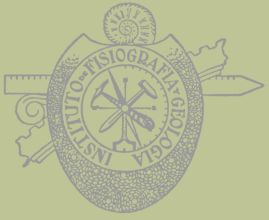 Instituto de
Fisiografía y Geología
Instituto de
Fisiografía y GeologíaFacultad de Ciencias Exactas, Ingeniería y Agrimensura
Universidad Nacional de Rosario
Laboratorio de Paleontología y Biocronología
 Instituto de
Fisiografía y Geología
Instituto de
Fisiografía y Geología
Facultad de Ciencias Exactas, Ingeniería y Agrimensura
Universidad Nacional de Rosario
Luciano Brambilla
Laboratorio de Paleontología,
IFG, FCEIA, Universidad Nacional de Rosario
Pellegrini 250, 2000 Rosario,
Argentina
Tel.: +54 0341 4802649-53 (interno 135)
lbrambilla [@] fbioyf.unr.edu.ar
Instituto de Fisiografia y Geología
» Paleontología del Cenozoico
P u b l i c a t i o n s
|
Luciano Brambilla, Paula López & Damián Ibarra (2021). Report of Microcavia cf. robusta (Rodentia, Caviidae) from the late Pleistocene of Santa Fe, Argentina Boletín del Instituto de Fisiografía y Geología, 91:17-20.
Parent H., Garrido A.C., Brambilla L. & Alberti M., (2020). Upper Bathonian ammonites from Chacay Melehué (Neuquén Basin, Argentina) and the chronostratigraphy of the Steinmanni Zone. Boletín del Instituto de Fisiografía y Geología, 90:1-37.
Brambilla, L., Toledo, M. J., Haro, J. A., & Aguilar, J. L. (2019). New
osteoderm morphotype (Xenarthra, Mylodontidae) from the middle Pleistocene
of Argentina. Journal of South American Earth Sciences, 95, 102298
Brambilla, L., & Ibarra, D. A. (2019). Archaeomylodon sampedrinensis, gen.
et sp. nov., a new mylodontine from the middle Pleistocene of Pampean
Region, Argentina. Journal of Vertebrate Paleontology, e1542308.
Parent H., Garrido A. C., Schweigert G & Brambilla L. (2019).
Pseudosonninia, a new genus of oppeliid ammonite (Haploceratoidea) from the
Callovian (Middle Jurassic) of the Neuquén Basin, Argentina. Volumina
Jurassica, 17:39–48
Parent H., Garrido A. C., Scherzinger A., Schweigert G. & Brambilla L.
(2019). Ammonites of the subfamily zapaliinae from the lower Tithonian of
estancia María Juana, Vaca Muerta formation (Portada Covunco member),
Neuquén basin, Argentina. Rivista Italiana di Paleontologia e Stratigrafia,
125(2):473-488
Brambilla, L., & Ibarra, D. A. (2018). The occipital region of late
Pleistocene Mylodontidae of Argentina. Boletín del Instituto de Fisiografía
y Geología, 87:1-9
Alberto C. Garrido, Horacio Parent, Luciano Brambilla (2018). Tithonian
stratigraphy and ammonite fauna of the Vaca Muerta Formation in Mallín
Quemado (Neuquén basin, Argentina), with remarks on the andean
chronostratigraphy. Volumina Jurassica, 16:1-26.
Brambilla, L., & Ibarra, D. A. (2017). A new species of Eutatus Gervais
(Xenarthra, Dasypodidae) from the Late Pleistocene of the Northern Pampean
Region, Argentina. Palaeontologia Electronica, 20:1-9.
Brambilla, L., & Ibarra, D. A. (2017). Ornamentation and defense structures
of the pelvic buckler of Eutatus pascuali (xenarthra, dasypodidae). Boletín
del Instituto de Fisiografía y Geología, 87:17-22. |